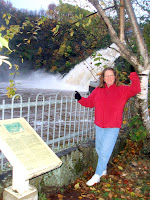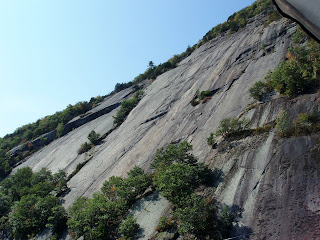 Sometimes I feel like I’ve dropped into Garrison Keillor’s Lake Wobegon or I’m in a Disney movie here at Rainbow’s End RV Park.
Sometimes I feel like I’ve dropped into Garrison Keillor’s Lake Wobegon or I’m in a Disney movie here at Rainbow’s End RV Park.At Rainbow’s End RV Park, everyone smiles and says, “Hello” when walking along the streets. Because the speed limit is only 10 miles per hour, you can see folks in cars or their RVs give a friendly nod as a greeting. Some people ride in covered golf carts. I saw one cart the yesterday with a warning sign posted saying “Blind Driver.” Streets have nice names like Providence Road, Rainbow Drive, Promise Lane and Sunrise Drive.
At Rainbow’s End RV Park all the men are handy at repairs, installations, and RV maintenance. All the women can make pot luck dishes from whatever’s in their RV pantry. Ice cream is served on Sunday nights at the Activity Center and lunch at the Club House on Tuesdays is an affordable $3.
There are no children at Rainbow Park, but all the grandchildren spoken of are beautiful, taking advance placement classes, and looking forward to Grandma’s & Grandpa’s next visit.
There are a lot of dogs at the park. Every hour of the day people are outside with dogs on a leash. One lady drives her motorized cart while her poodles strut ahead as if they were pulling her along. Some dogs are yippy and others are shy. Some are protective like the one dog who grabbed Ed’s pant leg to keep him from entering an RV even though he was invited inside.
There are dogs on the roads surrounding the Park too. When I ride my bike on these roads, they begin to bark just like the yipping in Disney’s 101 Dalmatians. One dog begins the cry and soon every dog down the road is barking, “Here comes Patty on her bicycle!” Many of these dogs are confined in fenced yards. I keep waiting and watching for one in a frantic run to someday skid into the metal mesh, but to date and to my amusement, they always stop an inch shy of crashing. One dog is particularly ferocious. I keep trying to outsmart this growling white dog. There’s no fence around his yard so he lunges at the wheels of my bike. He hasn’t learned to stay off the road and keep his nose out of the spokes. He’s chased me every time I pass his way and once he lost some of that white hair in the bicycle spokes.
Rainbow’s End RV Park is a special place for members of the RV Club Escapees. Most people who park here are fulltime RVers. They’ve mostly all given up a house and possessions to live on the road. Conversations here center on places they have been or places where they dream to go. There are a few who are like me, experiencing the detoxification of the corporate treadmill. Most are well into retirement and have lived as fulltime RVers for more than 7 years. They’re eager to offer advice and encouragement when the space gets too tight in the RV.
Ed and I arrived here on the Wednesday before Thanksgiving and will stay until New Years Eve in this friendly, near-to-fiction place.













 Parking the coach at the Mint presented no problem, Ed found a spot on the avenue for buses only. Leaving the Mint was not so easy. We wanted to travel to Gatineau, Quebec across the river from Ottawa but our selected route was barricaded. Orange signs detoured us thru a park. Lovely, except there were bridges linking the little islands of the park across an inlet of the Ottawa River. They looked fragile and low! Backing up was not an option with the tow dolly hauling our Toyota, so Ed and I got out of the coach to make a decision to cross or not to cross. Traffic backed up behind our coach. Irritated drivers cut around us. Curious ones waited to see if we dared to cross.
Parking the coach at the Mint presented no problem, Ed found a spot on the avenue for buses only. Leaving the Mint was not so easy. We wanted to travel to Gatineau, Quebec across the river from Ottawa but our selected route was barricaded. Orange signs detoured us thru a park. Lovely, except there were bridges linking the little islands of the park across an inlet of the Ottawa River. They looked fragile and low! Backing up was not an option with the tow dolly hauling our Toyota, so Ed and I got out of the coach to make a decision to cross or not to cross. Traffic backed up behind our coach. Irritated drivers cut around us. Curious ones waited to see if we dared to cross. 





































